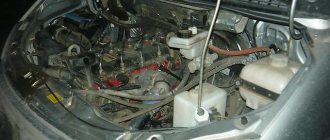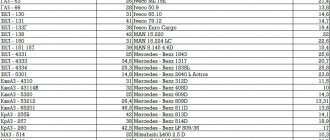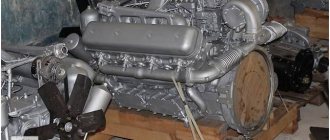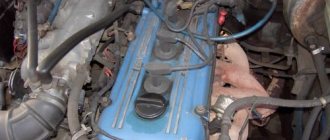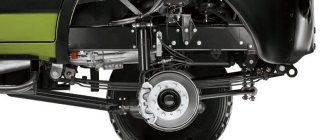There are many different trucks on the Russian market, both domestic and foreign.
One of the most practical and reliable types of equipment produced in our country is the GAZ-33106 Valdai.
The model of medium-duty truck under consideration has been improved many times and equipped with a large number of power units. But the most common modification is GAZ-33106 Valdai. Today, the 106th is equipped with four types of engines:
- D-245.7E3 MMZ;
- ISF 2.8s3148T;
- ISF 3.8s3154T;
- YaMZ 53441.
Each of them has many advantages.
Find out the technical characteristics of the GAZ-3302, the leader among domestic light-duty vehicles. In this article you will find a description of the Uralets-220 mini-tractor.
The most common is the Valdai with the D-245 engine. It has the following operating parameters:
- combustion chamber volume – 4,750 cm3;
- compression ratio – 17;
- power – 87.5 kW;
- the maximum torque value is 1,500 min-1.
The engine runs on diesel fuel, which somewhat reduces its power.
The volume of the combustion chamber is slightly smaller than that of the D-245. Despite this, the engine labeled YaMZ-53441 has the following characteristics:
- combustion chamber volume – 4,430 cm3;
- compression ratio – 17.5;
- maximum torque – 2,100 min-1;
- power – 99 kW;
YaMZ-53441, like the D-245, is diesel.
GAZ-33106 can be equipped with two types of foreign-made engines. They are four-stroke, diesel, turbocharged and intercooled. The cylinders in these engines are arranged in a row.
They differ from each other in the volume of the combustion chamber and, as a result, in power. ISF 2.8s3148T Beijing Foton Cummins has the following performance characteristics:
- working volume of the combustion chamber – 2,775 cm3;
- compression ratio is 16.7;
- maximum power at 3,200 min-1 – 110 kW;
- maximum torque – 2,700 min-1.
The second engine is more revving due to the increased volume of the combustion chamber, which is 3,760 cm3. Other characteristics:
- compression ratio – 17.2;
- power at 2600 min-1 - 112 kW;
- maximum torque – 1,900 min-1.
ISF engines have some technical features that greatly distinguish them from their domestic counterparts. First of all, this is the presence of a turbocharger, it is due to it that the power of these engines is so great.
The engines are also equipped with a cast iron sleeveless block. It has a common head for all cylinders, and each of them has 4 valves.
The gas distribution mechanism of ISF units is located on the same side as the flywheel, a single-row chain. This allows you to significantly reduce the noise level.
This is also facilitated by the use of composite materials for the manufacture of the pan and the valve cover itself. The automatic chain tensioner does not require maintenance until the first engine overhaul.
Its resource, according to the manufacturer’s application, is 500 thousand km. The engines of all modifications have a longitudinal arrangement, the cab type is half-hood.
The total weight of the vehicle is usually at least 7,400 kg. The load on the front axle of the truck is 2,200 kg, on the rear axle – 5,200 kg. Cummins is more resourceful, and a car equipped with such a unit can easily travel at a speed of 105 km/h.
The acceleration dynamics, of course, will not be able to amaze with their performance. But this is not what is needed from a car for transporting goods. On a domestic engine, the Valdai accelerates to 80 km/h in 45 seconds, on a Cummins – in 40 seconds.
Fuel consumption also varies greatly between different engines. To drive a YaMZ engine 100 km at a speed of 60 km/h, you will need 13.6 liters, when driving 80 km/h - 18.1 liters. In this regard, Cummins is much more economical. At a speed of 60 km/h you will need 12.1 liters for every 100 km, at 80 km/h - 15.1 liters.
Fuel consumption standards for dump trucks
For dump trucks and dump truck trains, the standard value of fuel consumption is calculated using the formula:
Qн = 0.01 x Hsanc x S x (1 + 0.01 x D) + Hz x Z, (4)
where Qн is the standard fuel consumption, l;
S — mileage of a dump truck or road train, km;
Hsanc is the fuel consumption rate of a dump truck or a dump truck train:
Hsanc = Hs + Hw x (Gpr + 0.5q), l/100 km,
where Hs is the transport norm taking into account transport work (with a load factor of 0.5), l/100 km;
Hw is the rate of fuel consumption for the transport operation of a dump truck (if the coefficient 0.5 is not taken into account when calculating Hs) and for the additional weight of a dump trailer or semi-trailer, l/100 t x km;
Gpr - dead weight of a dump trailer, semi-trailer, t;
q - load capacity of a trailer, semi-trailer (0.5q - with a load factor of 0.5), t;
Hz - additional fuel consumption rate for each trip with a load of a dump truck, road train, l;
Z—number of loaded riders per shift;
D — correction factor (total relative increase or decrease) to the norm, %.
When operating dump trucks with dump trailers, semi-trailers (if the basic rate is calculated for the vehicle, as for a truck tractor), the fuel consumption rate increases for each ton of the trailer's, semi-trailer's own weight and half of its rated load capacity (load factor - 0.5): gasoline - up to 2 l; diesel fuel - up to 1.3 l; liquefied gas - up to 2.64 l; natural gas - up to 2 cubic meters. m.
For dump trucks and road trains, the fuel consumption rate (Hz) is additionally established for each trip with a load when maneuvering at loading and unloading areas:
— up to 0.25 liters of liquid fuel (up to 0.33 liters of liquefied petroleum gas, up to 0.25 cubic meters of natural gas) per unit of dump rolling stock;
- up to 0.2 cubic meters m of natural gas and 0.1 liter of diesel fuel approximately with gas-diesel engine power.
For heavy-duty dump trucks of the BelAZ type, the additional diesel fuel consumption rate for each trip with a load is set at up to 1 liter.
In cases of operation of dump trucks with a payload coefficient above 0.5, it is allowed to normalize fuel consumption in the same way as for on-board vehicles according to formula (3).
Models
The incredible reliability and endurance of these power units have earned well-deserved fame among both experienced motorists and drivers of the current generation. 8s3154 Type Diesel, 4-stroke, with turbocharging, charge air cooling, liquid cooling Number and arrangement of cylinders 4, vertical in a row Order of cylinders 1 3 4 2 Direction of rotation of the crankshaft Right Cylinder diameter and piston stroke, mm 102 115 Displacement, l 3.76 Compression ratio 17.2 Rated net power, kW l.
Valdai diesel consumption per 100 km Modifications and options
| Order of the Ministry of Transport of the Russian Federation dated March 14, 2008 No. AM-23-r Appendix Fuel consumption standards for onboard trucks If the on-board self-diagnosis system of the engine control unit does not produce any fault codes and there are no obvious and immediately understandable reasons why . It is believed that the base engine of the UAZ Bukhanka is the UMZ 421 gasoline engine, various modifications of which, carburetor and injector, are still produced. |
Re: FUEL CONSUMPTION IN VALDAI WITH KAMINS • The power system in a modern injection engine depends on the control unit.
Engines
In case of repair, it is important to use original Cummins spare parts to ensure the high technical characteristics of the engine declared by the manufacturer. LAWN Next, which just recently went on sale, has stirred up the world of commercial vehicles not only with its attractive design and comfortable interior, but also with its outstanding technical characteristics, which are worth dwelling on in more detail.
"Valdai" GAZ-33104
The products of the Gorky Automobile Plant are primarily associated with commercial vehicles. Well, the most important thing for buyers of such products is the optimal ratio of quality and price. Focusing on these points, the GAZ-3310 Valdai was created (but its modification GAZ-33104, which we will consider, went into production)
And here the Gorky team hit the nail on the head - they produced a successful and reliable car, which in its consumer qualities is superior to many foreign analogues. This was confirmed by the fact that Valdai, being “at the peak of its career,” was the best-selling medium-duty truck in Russia – leaving foreign cars far behind.
GAZ-33104 “Valdai” is a medium-tonnage low-bed truck belonging to the “N2” category. In fact, it is a kind of intermediate option between “light-duty commercial vehicles” and “full-fledged medium-duty trucks.”
Structurally, the vehicle is practically no different from the “original onboard GAZelle”, except in dimensions and load capacity. The length of the "Valdai" is 6050 mm, height without awning - 2245 mm, with awning - 2980 mm, width - 2185 mm, and including mirrors - 2643 mm.
In terms of appearance, the GAZ-33104 is, in fact, “the same GAZelle” from which the cabin was borrowed. The interior of the car is simple and well thought out, ergonomics are at the proper level, all controls are based in the right places (except that the horn on the left lever is still not entirely convenient). But the plastic used is hard, and everything is assembled not very well.
The “basic Valdai” cabin has three seats, the adjustment ranges are sufficient to optimally set up a comfortable workplace, but the seats themselves cannot be called a “standard of comfort”. The instrument panel is simple and functional, but most importantly, it is easy to read under any conditions.
GAZ-33104 is suitable specifically for urban and intercity transportation, as evidenced by the “European” version of rims with a diameter of 17.5 inches. This solution not only improves maneuverability, but also provides a low loading height - only 985 mm.
"Valdai" is equipped with a metal cargo platform with folding sides, and the side itself can be equipped with an awning on a frame base. The length of the loading area is 3500 mm.
This Russian medium-tonnage vehicle is capable of taking on board 3815 kg of cargo, however, thanks to the GAZ-4301 frame (which underlies the chassis), there is a large margin of safety - therefore, even double overloads almost always (on flat roads) for this vehicle remain “unpunished” (in terms of frame integrity).
Specifications. Under the hood of the “original Valdai” there is a Belarusian-made MMZ D-245.7E-3 engine that meets Euro-3 environmental standards. It is equipped with very expensive Common Rail equipment from Bosch, which makes it more sensitive to poor quality fuel. The working volume of the four-cylinder turbodiesel with liquid cooling and direct fuel injection is 4.8 liters. It produces 119 horsepower at 2400 rpm and 420 Nm of peak torque at 1400 rpm. The engine is combined with a 5-speed manual transmission, through which power is directed to the rear axle.
Reviews about Valdai
Mikhail writes:
I am the owner of Valdai (GAZ-33104). There is an isothermal booth 5 m long. The current mileage is 181,000 km.
Engine – MMZ D-245. Pulls very well, regardless of gear and speed. But the Bosch fuel system is more trouble than it's worth.
With the Common Rail, the engine runs smoother, I don’t argue, but there are no fewer sensors than on the fuel-injected Kalina. The turbine is blowing, tearing pipes to the intercooler, snotty, diesel fuel is passing by.
Box from GAZ-3309. She is neither bad nor good. True, they hung it by the middle part, which is why the fastenings cracked. The clutch pedal is very tight.
The steering is the same as that of passenger cars. In my opinion, the steering wheel is too light. But I can’t say that this is a serious problem.
Lawn frame. She's quite strong. Attached to it is a battery box containing two batteries (each 210 Ah).
The suspension works fine, but only if you take no more than 3.5 tons on board. When you load 5 tons, problems begin. The truck has weak springs and anti-roll bars.
The brakes are pneumatic and full disc. The rear ones sometimes jam (you have to wait until they cool down). The pedal is tight, but if you press it hard, the car stops dead in its tracks. The discs are too delicate - they are afraid of salt and dirt. Yes, and they are expensive. For a caliper they ask from 15,000 rubles.
The cabin is Gazelle with all that it implies. The plastic has lost its original appearance, the deflectors are covered, the light switches and stoves are very loose. Advantages: soft turn switch, comfortable and pleasant steering wheel, fairly comfortable seats.
I have no serious comments about the isothermal booth. I am satisfied with both the volume and the way it is assembled.
Lev writes:
"Valdai-331043" was purchased in 2009 - from an official dealer, new. The truck is equipped with a body with an awning and is used for transporting any non-food cargo. It is very convenient to transport furniture, since the six-seater cabin provides space for a team of loaders.
Over the five years of operation, there have been no significant malfunctions or failures of expensive elements.
The real average consumption is about 19-22 liters per hundred. You often have to drive on bad roads.
The mileage is 70 thousand km, and during this time only the longitudinal steering rod was replaced in the chassis (when the odometer showed 48 thousand km).
The brakes are excellent and efficient and still have the factory pads installed. The original tires gave way to new Kama tires. The car is excellent, I service it on time, I do it myself.
Valdai writes:
Valdai has proven itself mainly on the positive side. The car is unpretentious in operation. We can note the simplicity of the device, inexpensive maintenance and service, high maintainability, reliability, and the availability of spare parts literally at every step. The body has a large volume, the load capacity is quite high, and fuel consumption is acceptable. It pulls four tons without straining. The cabin is warm and comfortable, visibility is good. It is quite easy to control. In general, the main thing is to monitor Valdai, change consumables on time, and there will be no problems. I've been driving it for about three years, and there haven't been any significant breakdowns yet.
Andrey writes:
Optimal price/quality ratio! Reliable and time-tested truck!
It’s very strong, doesn’t notice overloads at all, the engine pulls decently, fuel consumption is acceptable.
But the front tires quickly wore out - after 30 thousand km they had to be replaced with a new one (the rear tires were fine).
Operating principle © Technical specifications
| FUEL CONSUMPTION IN VALDAI WITH KAMINS Almost every car driver wants less fuel to be consumed, but the driving distance does not increase, and engine power does not decrease. For cargo flatbed vehicles and road trains performing work counted in ton-kilometers, in addition to the basic norm, the fuel consumption rate increases on the basis of liters for each ton of cargo per 100 km, depending on the type of fuel used for gasoline - up to 2 liters; diesel fuel - up to 1.3 l; liquefied petroleum gas LPG - up to 2.64 l; compressed natural gas LNG - up to 2 cubic meters. |
- GAZ-331041 (331042) have a wheelbase extended by 900 mm and a rear overhang by 600 mm, as a result of which the length of the cargo area is increased, which makes it possible to transport larger items.
- GAZ-331043 is equipped with a “double-row” cabin with six seats, the length of the platform is comparable to the base model, but the wheelbase is 4000 mm. Of course, such a car is convenient for a team of four or more people, but access to the rear seats is organized inconveniently. The fact is that this “Valdai” has only two doors, so you have to climb to the second row through a narrow opening, which is very difficult.
- GAZ-33104V is a rather original modification - a truck tractor that works with a flatbed semi-trailer 7.5 or 11 meters long. The carrying capacity of such a vehicle varies from 5000 to 6500 kg. It is noteworthy that the cabin of the Valdai truck tractor is equipped with two berths, making it convenient to use the vehicle in intercity transportation, where it is economically unprofitable to use a standard Eurotruck.
Compound
gasoline consumption for Ford Focus 3
truck consumption per 100 km diesel
Valdai what category of rights © Technical stuffing
| Valdai cars GAZ-33106, GAZ-331061, GAZ-331063 Cummins ISF The Valdai dump truck platform is metal, which has an opening tailgate, there is manual control of the locks, unloading is carried out backwards, the platform is tilted 50 degrees, the platform tilting mechanism is a hydraulic hydraulic cylinder for tilting the platform telescopic plunger type, having a one-way action, electro-pneumatic lifting and lowering of the platform, carried out remotely, from the driver’s cabin by switches installed on the instrument panel. For example, the Gorky Automobile Plant has been equipping its GAZ-3309, GAZ-33081 Sadko and GAZ-33104 Valdai cars with these economical and easy-to-maintain diesel engines for many years. |
- Europlatform, awning
- Isothermal van
- Dump truck
- Flatbed truck with CMU
- Tow truck
A normal workhorse.
But this truck's element should be narrow city streets, so the inherited maneuverability became a more important acquisition, while the capacity of the cargo compartment was increased. To place 16-valve ZMZ-405, 406, 409 in the engine compartment of UAZ 31512, 31514, 3153, significant modifications to the frame, body, electrical wiring, and engine systems are required.
So what should you choose? : Modifications with injector
As for the external design, the cabin of the Valdai Next truck clearly hints at its Chinese origin, although it was this design, along with the exterior, that was once borrowed, or rather, completely copied from Japanese light-duty trucks. In addition, the engine is equipped with a pre-heater, and is paired with a new mechanical 6-speed transmission of GAZ’s own production, which, as the developers assure, has a much longer service life than the previous five-speed gearbox.
| Engine | Consumption (city) | Consumption (highway) | Flow (mixed) | Fuel type |
| 2.3 MT 116 hp (Mechanics) | 12,5 | 9,5 | 11,4 | Diesel |
| 2.2 MT 114 hp (Mechanics) | 12,5 | 9,5 | 11,4 | |
| 2.7 MT 149 hp (Mechanics) | 14,5 | 11,6 | 12,7 | Petrol |
| 2.7 MT 135 hp (Mechanics) | 14 | 10,4 | 12 |
A car for work... Technical specifications
| New Valdai Next (GAZ) 2022 PRICES 2.7 MILLION! Photos, equipment Sealing mastics have been introduced that absorb noise and vibration, as well as prevent the formation of corrosion in places where metal parts come into contact, welds, and flanges. The UAZ Bukhanka car is designed for driving on uneven roads, adapted for convenient operation both in the city, on the highway, and in areas with problematic roads. |
| GAZ 33104 (Valdai) characteristics and price, photos and review However, it was not without the influence of Asia, as in the case of the KAMAZ truck, they also decided to equip the Valdai Next with a Chinese cab, and if the Compass got a semi-finished product from JAC, then the new GAZ cab produced by Foton. The carburetor is very sensitive to temperature conditions, it tolerates both low and high temperatures very poorly, to the point that carburetor parts can freeze. |
- Kirill, Yekaterinburg. I have a 2014 “Loaf”, 2.7 engine (ZMZ 409), injector, very high quality and reliable car. I operate the car in completely different conditions. Recently I was driving along the highway from Yekaterinburg to Alapaevsk with a light load (350 km), on average I kept a speed of 80-90 km/h, and the average consumption was 12.5 liters per hundred. After which I drove on dirt roads (muddy in places), with rear-wheel drive, without serious descents or ascents, resulting in 18 liters per 100 km. I have a modification with installed additional attachments: a winch on the “face”, which is another 40 kg of extra weight, MT wheels, rear locking. Bottom line: the car is excellent, of course, the comfort in the cabin is incomparable with an imported SUV, but overall it’s enough for everyday work. I'm happy with the car, and the consumption in urban conditions of 16 liters also suits me.
- Alexey, Vorkuta. The real fuel consumption of the “Loaf” is 13.5 liters in the city with a 2.5-liter engine, although many owners complain that their car consumes 15, 18, and even 20 liters. I am sure that the engine’s “gluttony” indicator depends on the technical condition, as well as on what driving style the owner adheres to. Of course, modifications with a carburetor consume slightly more fuel than injection versions. I have a modern model UAZ-452 2012, and in terms of saving money I have never had any problems. You can install gas, but, as for me, this is an extreme and necessary measure. I want to say right away that you won’t be able to save on gasoline. Already old cars with high mileage burn on average 17-18 liters - this is a fact. New ones rarely go beyond the official fuel consumption limits, and if this happens, you need to look for the reasons!
- Igor, Perm. I will also express my opinion about this car. I believe that it is mandatory to install gas equipment on UAZ vehicles. There is plenty of space in the “Loaf” for this, the loss of power will be a maximum of 20%, while the savings on fuel refueling are colossal. Although, loss of power is a questionable thing. With proper setup of the equipment it is practically not felt. I have a UAZ Bukhanka 2022 with an injection engine, and I immediately decided to install an LPG. On gasoline the engine consumes 12-13 liters in the city, and with gas 14-15 liters. The difference is small, but “blue” fuel is much cheaper. Thanks to the higher octane number, the installation gets rid of all the negative consequences of detonation. In general, I personally see only some advantages from operating the UAZ-452 with gas equipment, and not a single obvious disadvantage.
Review of the characteristics of the MMZ D-245 diesel engine
The products of the Minsk Motor Plant have been known on the Russian market for many years. MMZ engines have proven themselves to be the best. The incredible reliability and endurance of these power units have earned well-deserved fame among both experienced motorists and drivers of the current generation. It is difficult to find an automobile plant in the post-Soviet space that has not previously produced, or does not currently produce, trucks (heavy, medium, light) and buses equipped with MMZ D-245 diesel engines and its various modifications. Among the consumers of MMZ diesel engines in general and D-245 in particular are such well-known auto giants as GAZ, MAZ, PAZ, ZIL and many others. For example, the Gorky Automobile Plant has been equipping its GAZ-3309, GAZ-33081 (Sadko) and GAZ-33104 (Valdai) cars with these economical and easy-to-maintain diesel engines for many years.
The positive qualities of diesel engines in general are, without a doubt, known to all motorists. The main factor is, of course, the high efficiency of diesel compared to its gasoline counterpart. For example, the fuel consumption of the Valdai and GAZ-3309 is 14-18 liters/100 km, while the Sadko, which is all-wheel drive, by the way, is only 16-19 liters per hundred kilometers. In addition, diesel engines in general and the D-245 engine in particular have higher efficiency due to a higher degree of compression of the working mixture and, accordingly, its most complete combustion. Reduced fuel consumption and its lower cost make cars equipped with MMZ D-245 engines a lifesaver not only for small and medium-sized businesses, but also for large construction and agricultural companies. After all, the greater the capacity of the equipment in use, the higher the final savings. In addition, no one can dispute another positive quality of diesel fuel - its ability to act as a natural engine lubricant.
But the efficiency of the D-245 is not limited only to the fuel component. Like the entire family of diesel power units, the service life of MMZ engines is almost twice as high as that of their gasoline counterparts, due to the more durable block, connecting rod and piston group and other engine parts.
When choosing an engine for a commercial vehicle, and especially a truck, of course, you should pay attention not only to efficiency, but also to engine power. MMZ D-245 engines are very high-torque, which means they can save not only on fuel, but also through more efficient use of the equipment on which they are installed, increasing the volume of cargo transportation and reducing the number of flights.
Diesel engines have virtually no disadvantages. Former problems associated with difficult engine starting in the cold season have sunk into oblivion thanks to the use of glow plugs and low-viscosity oils in diesel engines, which, if the starting procedure is carried out correctly, make it easy to start the engine even in 30-degree frost. The second most common argument against using a diesel engine is its reduced speed compared to its gasoline counterpart. However, it is worth noting that we are talking about power units for commercial vehicles - buses and trucks, which can hardly be classified as racing cars. Therefore, leaving such an exotic activity as racing on trucks and buses to professional racers and circus groups, we still note that the use of a turbocharging system in a diesel engine reduces the difference in speed of cars equipped with diesel and gasoline engines to almost nothing.
